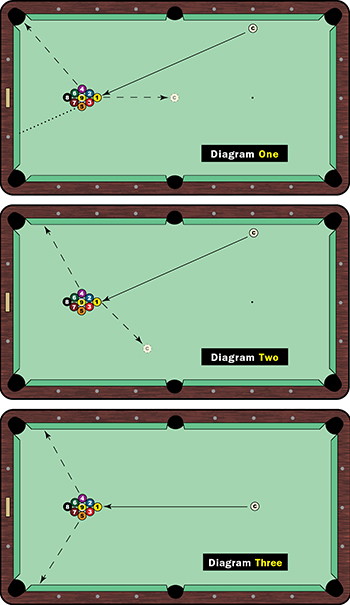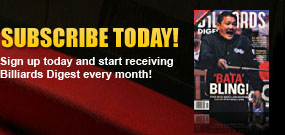Don’t make amateur mistakes on your 9-ball break.
With all of the coaching I do and chatting with amateur players, the most common questions are about the break shot.
The easiest way to explain the break shot in 9-ball is to point out the most common mistakes amateurs make and explain the consequences.
First, amateurs almost always have their eyes trained on the 1 ball during their backswing. Because you are trying to generate more power with the break than any other game shot, you really need to keep your eye on the cue ball. The harder you hit the ball, the more difficult it is to keep your stroke straight. Keep your eyes on the cue ball and make sure you strike it exactly where you intend to strike it. Of course, you should look at where you want to hit the 1, but when you are preparing your last practice stroke, shift your eyes to the cue ball contact point.
Another key mistake is where amateurs aim to hit the 1 ball. Most amateurs attempt to hit the 1 ball as if they were breaking from the center of the table. The problem with this is that the cue ball will travel wide to the left. That, in turn, presents a number of potential problems — scratching in the side pocket; the wing ball going to the long rail. The risk is high with this approach, and the chances of making a ball are slim.
Amateurs tend to aim either too high or too low on the cue ball. Additionally, because they are trying to hit the cue ball so hard, they tend to lift their head and body too early. If that happens, all bets are off. You’ve lost control of the cue ball and you will likely miss the intended contact point on the 1 ball by a wide margin. Reduce your power and you will gain control. Once you learn to control the cue ball and strike the 1 with precision and consistency, you can gradually add power to your stroke.
Diagram One offers the perfect set up. I always check my alignment and sighting before I get down over the shot. My line of sight is through the 1 ball to the first diamond on the bottom rail (dotted line). I aim just below center on the cue ball (no English) and hit the 1 ball square. At contact, my eyes are always on the cue ball. Pure contact is essential, and I make sure my arm extends through the shot. If the rack is good, you’re guaranteed to pocket the wing ball (the 4 ball in the diagram).
Now take a look at Diagram Two. This is the result if you aim to hit the front of the 1 ball, as if you were shooting at it from the center of the table. This is a very common mistake. The result is that you lose control of the cue ball (and risk scratching into the side pocket), you do not get a good split from the rack and the wing ball will run short of the corner pocket.
Another mistake I see from amateurs is breaking from the center of the table (Diagram Three). They assume that breaking straight on will allow them to use maximum power and get full contact on the 1 ball. The problem is that the wing balls will invariably hit the long rail short of the corner pockets.
Next month: The 10-ball break.






